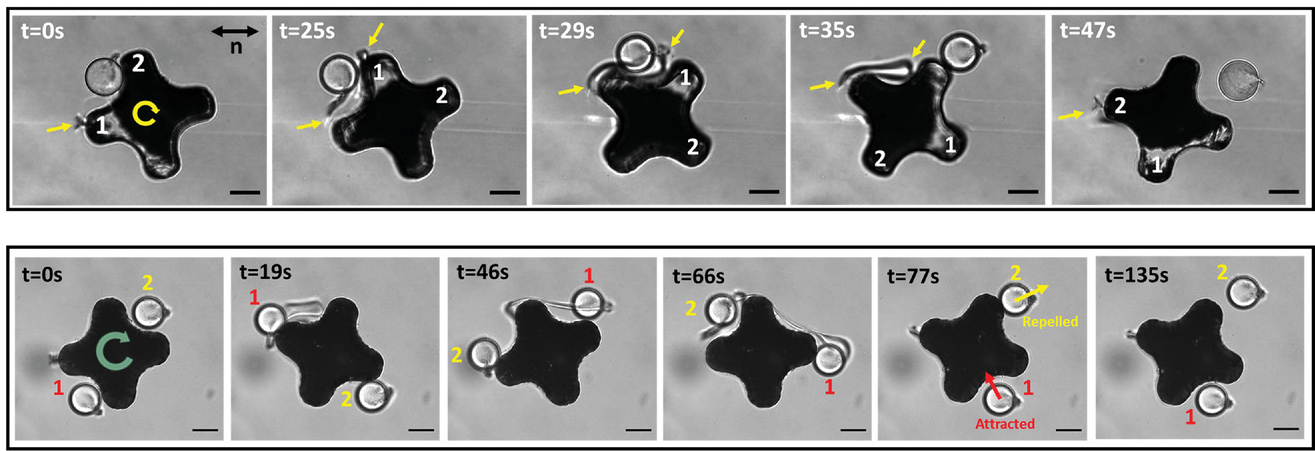
The researchers’ microrobots use “physical intelligence” to exert control over nearby objects. By spinning and disrupting the alignment of the liquid crystal surrounding them, the robots can attract smaller particles to their edges, then precisely deposit them.
(Image: Penn Engineering Today)
Penn Engineers are working to make controlling microscopic processes, such as transporting drugs to tumors for precise therapies, faster, safer, and more reliable through the use of microrobots.
Controlling microscopic processes is inherently challenging. The everyday tools used to manipulate matter on the macroscale can’t simply be shrunk down to the size of cell, and even if they could, the physical forces they rely on work differently when their targets are measured in nanometers. But while it’s no easy feat, attaining this type of control would pay enormous dividends, whether it’s transporting drugs to tumors for precise therapies, or making functional materials out of the liquid-suspended building blocks known as colloids. Penn Engineers are working to make these processes faster, safer and more reliable through the use of microrobots.
Since they’re too small for their own onboard computers, microrobots move about by means of an external magnetic force. And to manipulate equally small cargo, they need to take advantage of the different physical and chemical laws that rule the microscale.
At those sizes, every object is greatly influenced by the molecules surrounding it. Whether they are surrounded by gas, like the ambient atmosphere, or immersed in a liquid, microrobots must be designed to exploit this influence through a concept known as “physical intelligence.”
Kathleen Stebe, Richer & Elizabeth Goodwin Professor in Chemical and Biomolecular Engineering and Mechanical Engineering and Applied Mechanics, Tianyi Yao, a former Ph.D. student in her lab, Qi Xing Zhang, a current Ph.D. student, and collaborators in the group of Professor Miha Ravnik at the University of Ljubljana are conducting fundamental research that will lay the groundwork for understanding these small-scale interactions in a colloidal fluid of nematic liquid crystals (NLCs), the fluid that makes up each pixel in a liquid crystal display (LCD) screen.
In a study published in Advanced Functional Materials the research team describes a four-armed, magnetically controlled microrobot that can swim, carry cargo and actively restructure particles in this complex fluid.
Being able to manipulate processes on this level is groundbreaking, and understanding how robotic systems are able to perform tasks in an indirect way, considering the fluid dynamics and physical interactions of the media as a part of the microrobot’s design, is key.
Stebe and her team are now able to imagine real-world applications for this technology in the optical device industry as well as many other fields. Smart materials, aware of their environment, may be designed using temperature and light as controls for microrobotic tasks.
Original Article: Tiny swimming robots can restructure materials on a microscopic level
More from: University of Pennsylvania School of Engineering and Applied Science | University of Ljubljana
The Latest Updates from Bing News
Go deeper with Bing News on:
Synthetic molecular motors
- Revving Up a Protein Lawnmower
Scientists devised a synthetic protein-based motor fueled by biological reactions to cut through a peptide lawn.
- Biochemistry news
Light-driven molecular motors were first developed nearly 25 years ago at the University of Groningen, the Netherlands. This resulted in a shared Nobel Prize for Chemistry for Professor Ben ...
- Nanoscale gadgets
described how the supramolecular chirality of liquid crystals could be determined by the chirality of a synthetic molecular motor. By adding a small amount of a homochiral molecular motor to a ...
- More efficient molecular motor widens potential applications
Light-driven molecular motors were first developed nearly 25 years ago at the University of Groningen, the Netherlands. This resulted in a shared Nobel Prize for Chemistry for Professor Ben ...
- More efficient molecular motor widens potential applications
Light-driven molecular motors were first developed nearly 25 years ago at the University of Groningen, the Netherlands. This resulted in a shared Nobel Prize for Chemistry for Professor Ben Feringa in ...
Go deeper with Bing News on:
Magnetically controlled microrobot
- Magnetic microrobot swarms clean water of microplastics and bacteria
Microplastics are one of the biggest environmental and health risks faced by our generation. Now, researchers have developed swarms of tiny robots, or microrobots, that not only microplastics from ...
- Best Pest Control Companies Of 2024
Hiring a professional pest control service to eliminate and control these stubborn creatures is typically the best way to deal with the situation. Whether your home is in the grips of an invasion ...
- cruise control
It also colors our thinking of what is possible. Imagine if cars didn’t have cruise control and someone asked you if it were possible. Of course. Monitor the speed and control the gas using a ...
- Birth Control Pills
What Are Birth Control Pills? Birth control pills are contraceptives that use hormones to prevent a pregnancy. There are many methods of birth control. You may hear this specific one referred to ...
- Use a Runner’s World Discount Code to Save $200 on a Horizon Exercise Bike This April
$799.00 Shop Now With the 100 magnetically controlled resistance levels on the 7.0 IC, you can knock out whatever spin workout you have on your docket for the day, be it a high-octane interval ...










